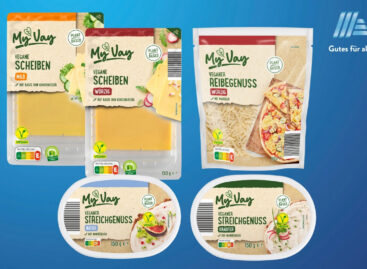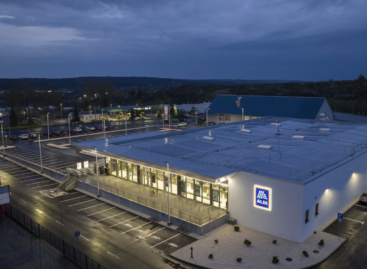2016 was a good year for Hungarian retail and for the country’s food industry
According to Nielsen, in 2016 Hungarian retail sales increased by 2.8 percent in value in the food and household chemicals market, in comparison with the previous year. This performance was much better than the 1.3-percent European sales growth in the 4th quarter of 2016. However, in comparison with 2015 when retail sales grew by 6.7 percent, the growth rate was definitely smaller
If all four quarters are considered, volume sales decreased by 1.1 percent, while prices augmented by 3.9 percent. Just for comparison: in Europe volume sales were up 0.4 percent and prices elevated by 1 percent. Nominal growth was 1.3 percent at a European level.
In Hungary grocery sales increased by 2.3 percent in value. Although volume sales dropped 1.1 percent, the 3.4-percent price increase turned sales in a positive direction. Value sales of household chemicals and cosmetics rose by a hefty 4.6 percent in 2016. This nominal value was the result of 1.1 percent lower volume sales and 6 percent higher prices.
During last year volume sales were moving in the negative zone in the first three quarters, but by the 4th quarter sales improved by a moderate 0.4 percent in Hungary. The European average was a 0.8-percent growth. On average the price increase in the Hungarian food and household chemicals market was 4.1 percent in a quarter by quarter comparison. In Europe prices elevated by 0.9 percent on average.
More optimistic consumers
In order to understand the drivers of the growth, let’s also take a look at how the consumer confidence index developed. In the 4th quarter of 2016 the index didn’t change: it was 64 points just like in the 3rd quarter, and this means that the above-60-point performance that had started in the second half of 2015 stabilised. Meanwhile Nielsen registered moderate growth in Europe, measuring 81 points on average at the end of last year.
From the three components of the consumer confidence index, in the last quarter of 2016 Hungarians were most optimistic about their personal finances: 25 percent (up 1 percentage point from the previous quarter) of Hungarians said their personal finances were good or very good. Hungarian consumers’ willingness to buy reduced by 4 percentage points and 19 percent said the next 12 months would be the right time to buy what they needed. If they have some money left having paid their utility and other bills, a bit more than a quarter of Hungarians (26 percent) improve their homes, 25 percent put money aside and 23 percent pay their debts. About one third of the survey’s participants (31 percent) said they never have any money left to spend freely (the European average is 19 percent).
The constant rise in the consumer confidence index and the stabilisation trend are manifested in buying trends as well. A growing proportion of consumers don’t plan their spending in advance. Back in 2014 nearly three quarters of consumers (73 percent) had a precise shopping budget, but by 2015 this proportion dropped to 53 percent and by 2016 it reduced further to 38 percent. This also means that consumers spend more money in shops, because they have a more optimistic financial outlook.
The performance of discount supermarkets improved further
GfK’s 2016 Retail Analysis revealed: from the various channels of retail it was discount supermarkets which increased their market share, while unorganised retail trade – street vendors, marketplace and other channels – lost some of their share if compared with 2015. What is more, discounters managed to increase their popularity among consumers younger than 40 years – more and more under-40 shoppers visit discount supermarkets (these stores are said to be the cheapest) to do their shopping.
Sales in hyper- and supermarkets grew thanks to increased buying intensity, which was the result of shoppers visiting these stores more and more often.
It is also true for discount supermarkets that growing buying intensity was the engine of sales growth, but in this channel the number of shoppers also increased a little. As for the sales increase in the drugstore channel, it was also driven by the growth in buying frequency.
Hypermarket customers remained to be the most loyal to their sales channel, they spend nearly one third of their total FMCG budget in this channel. Loyalty-wise the customers of discounters and supermarkets come next in the ranking – households that do their shopping in these channels spend one fifth of their total FMCG budget in these store types.
More people pay with bank cards than before
Perhaps relatively low motor fuel prices also had to do with the fact that more shoppers went shopping by car in 2016. Going shopping by car – because of the type of shopping and the fact that C&C stores are usually located outside of the city – still plays an important role in the sales of the C&C channel, where 92 percent of total sales is realised by this type of shopping trip. In the case of hypermarkets the share of this type of shopping is 76 percent, while in discount supermarkets it is 62 percent.
The proportion of bank card payments has been growing for years and in 2016 it reached 36 percent (based on product value paid this way) within the total sum paid. Bank card payment’s weight differs very much in various retail channels, but it is developing positively in all of them – the growth rate was the fastest, 8 percentage points in drugstores.
In 2016 small shops – which are done rapidly (‘I just go down to the corner shop and will be back in five minutes’), focus on only 1-3 product categories and are less influenced by promotions – were typically done in stores belonging to Hungarian-owned retail chains. About 48 percent of average shops – this is when 4-11 categories are purchased – were done in discount supermarkets, 43 percent occurred in hypermarkets and 40 percent took place in supermarkets.
Salaries increased
Last year retail sales expanded in all product groups. Grocery sales make up the biggest slice in retail’s cake and they were up nearly 3 percent in 2016. Sales of high-value consumer durables jumped 5 percent and clothes sales surged by 10 percent if compared with 2015.
Sales by online shops skyrocketed: in 2016 the sales growth neared 30 percent and e-commerce had been expanding at about the same speed in recent years.
The total value of retail sales was HUF 9,659 billion in 2016, from which FMCG sales amounted to HUF 3,294 billion. E-commerce’s value increased the fastest and reached HUF 303 billion last year.
Behind retail’s good performance last year we find the country’s economic growth, government measures helping families, VAT cuts and the low level of inflation. It also had a great influence on retail’s performance that in many areas of the national economy the workforce shortage forced employers to increase salaries considerably. Due to this, the purchasing power of Hungarians increased a lot. Gross monthly wages were up more than 6 percent last year.
Retail trade also suffered from not having enough workers to employ. In many cases the biggest retailers increased the salary of employees by two-digit numbers. This way they managed to keep the sector going, preventing a situation where work can’t be performed due to labour shortage.
It must also be mentioned that retail trade was a bit surprised by the government’s quick decision to abolish the ban on Sunday trading in April 2016. In line with shopper demand, retail trade returned to the opening hours used before the ban, but this step was difficult to take because of the workforce shortage.
The food industry also had a good year
Hungary’s food industry can also be satisfied with its performance in 2016. Decade-long trends turned around and there was growth in the sector, but this growth was smaller than the potential that lies in Hungarian companies. The VAT cut resulted in stunning data. Despite an improving performance and a whitening economy, Hungarian food products lost some of their domestic market once again.
According to statistical data, the Hungarian food industry expanded by 1.4 percent in 2016, more than the country’s industrial average. However, the growth rate was smaller than this in key agri-food sectors such as meat, dairy products, fruit and vegetable processing. Sectors that performed well include pet food manufacturing and non-traditional sectors such as isomalt and starch production.
When talking about the food industry’s development, we must mention the whitening effect of the VAT cut on the economy. This step was absolutely necessary in certain sectors, and it will also be one of the most important tasks in the future, as the black economy has been flourishing in other sectors too. The first breakthrough occurred in the pig sector, which constituted a learning curve in solving the problem for both legislators and market players. One of the lessons learned was that it is best if VAT reduction has a greater scope.
Dangerous competition
In spite of the promising indicators, the competitiveness of the Hungarian food industry didn’t increase in the domestic market either. According to preliminary data, food industry export rose by 1.6 percent last year, more than the sector’s total expansion. This also means that domestic sales had to develop around 1.2 percent in order to produce the 1.4 percent average growth. This is important data because it shows that the increase in domestic grocery retail sales – basically how much more food consumers purchased – was nearly 3 percent, while the domestic sales growth realised by food companies was less than half of this. Once again Hungarian consumers put more import products in their basket. This is true even if we know that domestic sales don’t purely mean consumer goods sales, as this fact has no major influence on sales data.
This proves that the Hungarian food industry is still struggling with competitiveness problems. Generally those products perform badly which are the most important among the goods purchased daily by consumers. When buying these, Hungarian consumers are driven by price and in this respect Hungarian food manufacturers keep losing the competition. Hungarian food companies won’t be able to compete with the lower prices of import products until they invest in technological development – for which they need state funding. This is the reason why companies in the food industry are waiting for grant schemes within the framework of the rural development programme and the Economic Development and Innovation Operative Programme (GINOP).
Hopefully 2017 will bring significant changes and in the next 1-2 years Hungarian food companies will invest mainly in technological development. //
Related news
Growth in Germany’s Plant-Based Food Market Continues
🎧 Hallgasd a cikket: Lejátszás Szünet Folytatás Leállítás Nyelv: Auto…
Read more >34 Hungarian exhibitors participate in ANUGA in Cologne
🎧 Hallgasd a cikket: Lejátszás Szünet Folytatás Leállítás Nyelv: Auto…
Read more >Related news
How do young adults celebrate?
🎧 Hallgasd a cikket: Lejátszás Szünet Folytatás Leállítás Nyelv: Auto…
Read more >Vajda-Papír celebrates Ooops!’s 15th anniversary with a hybrid AI campaign
🎧 Hallgasd a cikket: Lejátszás Szünet Folytatás Leállítás Nyelv: Auto…
Read more >Pre-holiday shopping at up to half price
🎧 Hallgasd a cikket: Lejátszás Szünet Folytatás Leállítás Nyelv: Auto…
Read more >






